The Pubs of Whitechapel
By John Smithkey III
While in London researching my book, I had the opportunity to visit the Ten
Bells Pub. This pub is probably the most famous pub in the history of Jack
the Ripper. Two victims were seen at the Ten Bells before they were murdered.
While lecturing on the mystery of Jack the Ripper, one of the most common
questions I am asked is "what pubs did the other victims patronize?
"
In order to address this question, one must examine the behavior of prostitutes
during this time period as well as the location of the other pubs in the area.
This will require a certain amount of educated speculation based on witness
statements and the review of the Ripper literature.
Walking from pub to pub in search of customers was common for prostitutes. As
an example, let us examine the behavior of Mary Kelly. Research by Cullen
(1945) discovered that Mary Kelly indeed visited other pubs. "Occasionally
she stopped for a quick one or another of the pubs along Commercial Street,
where with one swift glance she took in the trade possibilities at the bar
counter" (p.166). In fact, on the night of her murder, Kelly was also seen
by a witness drinking at the Horn Of Plenty Pub (Begg et al, 1996). In the
early morning hours of November 9, 1888 Kelly was also seen outside the
Britannia after drinking (Smithkey, 1998).
We now know that Mary Kelly frequented at least three pubs on the evening of
November 8, 1888. Even though her main pub of choice was the Ten Bells
(Cullen,1945). There can be little doubt that other prostitutes walked from
one pub to another in search of clients. The very nature of prostitution
required that the prostitute keep moving about in order to lessen her chances
of being caught by the police. The prostitute could be arrested if caught
standing still in an attempt to secure a client. Saint Botolph's Church is a
good example. At this location, the prostitutes had to keep walking in order
to avoid arrest. So, they simply kept walking around the church. Saint
Botolph's Church later had become known as "the prostitute's church"
Therefore the prostitutes walked up and down the streets, stopping at the
various pubs along the way in the hopes of securing a client.
Ripper history shows that the murders were committed within a small area of
Whitechapel and Spitalfields. We must now focus on the pubs in the area of
the murders during the autumn of 1888.
During my visit to the East End, I discovered that there were four pubs within
easy walking distance; The Ten Bells, The Alma, The King Stores, and The City
Darts (formerly The Princess Alice). Two other pubs in the Ripper literature,
The Horn Of Plenty and The Britannia no longer exists. So during the Autumn of
Terror of 1888, there were a half a dozen pubs within a small area that the
prostitutes could easily visit.
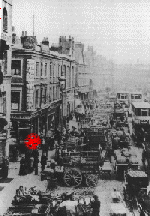
Above: A contemporary photo showing the Britannia at foreground, left.
The red dot corresponds to the same spot on both photos.
The Britannia was located at the corner of Dorset Street and Commercial. It
was demolished in 1928 to make room for the expansion of the Spitalfields
Market (Begg et al 1996). The Horn Of Plenty stood on the opposite end of
Dorset Street, on the north corner of Crispen Street and Dorset Street. The
Horn Of Plenty also is no longer standing. The four remaining pubs will be
discussed as they relate to the history of Jack the Ripper.
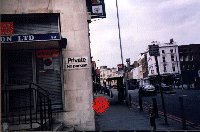
Above: Modern day photo of the same area. The Britannia used to stand near
where this building is today (left foreground). The Ten Bells is located
under the white building on the far right.
The Princess Alice (below) stands at the corner of Wentworth Street and
Commercial Street. During the 1980s the pub was remodeled and the name was
changed to The City Darts. Today, the City Darts is the regular meeting
place for the Cloak and Dagger Club. But in 1888, the pub played an important
role for two people in the Ripper case.

First, the pub is credited with being frequented by John Pizer, who was also
known as "Leather Apron". Although Pizer did threaten prostitutes
with a knife, and was heard to say "I'll rip you up", he was cleared
of the murders at Chapman's inquest. It was also at the Princess Alice that
Frances Coles was picked up and later found a victim of a knife assault. She
died a short time later. At first thought to be a victim of Jack the Ripper,
it was proved otherwise. Coles was however, the last official victim of the
Whitechapel Murders.
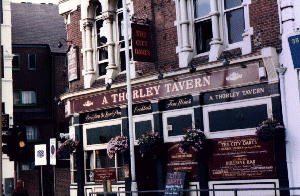
The Alma Pub (below) is located on Spelman Street. The pub does have the
second floor decorated with Ripperana, such as posters, and paintings of
the Ripper scenes. This pub is located off the main streets of the East
End. Some of the Ripper walking tours do stop at this pub. The pub's
location on the back streets made it a good location for prostitution in
the days of the Ripper!
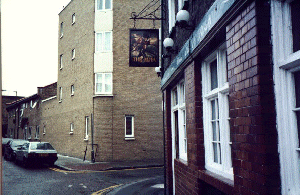
The final pub that will be discussed is the Kings Stores Pub. Located on the
corner of Widegate Street and Sandy's Row, it has a large sign outside the pub
that reads as follows: "JACK THE RIPPER LAST SEEN HERE 1888". But
the pub is not listed in any Ripper literature! Why? Was an important piece
of Ripper history missing, or is this sign merely a "tourist trap"?
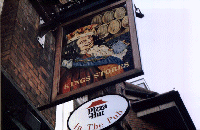
In order to confirm the pub's claim, I set out and investigated accounts of
known suspect sightings in the general area. One documented account occurred
at the corner where the pub is located. Rumbelow (1988) writes that on the
morning that Kelly's body was found, Mrs. Paumier was selling roasted chest
nuts at the corner of Widegate Street and Sandy's Row. She was asked by if
she heard of a murder in Miller's Court. When Mrs. Paumier said she did, the
stranger replied that "he knew more about it than she did"(p.96).
Begg et al (1996) confirms the location of this incident as the corner of
Widegate Street and Sandy's Row. It is also interesting to note that the
stranger was wearing a black coat, carrying a black bag.
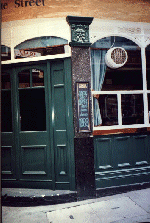
The Ten Bells Pub is the fourth pub mentioned in this article. The article
dealing with The Ten Bells in detail can be located at
Whitechapel, Then and Now: The Ten Bells Pub; that also contains detailed
photos.
It is the hope that this article will give the reader a good, general
introduction to the activities related to not only Jack the Ripper, but the
Autumn of Terror as well. When investigating history, you can never tell
what fascinating discoveries await. While investigating the Kings Stores'
involvement in the Ripper case, it was mentioned to me that the same building
was used by King Henry VIII as an arsenal! Although it has nothing to do with
Jack the Ripper, it certainly will be investigated on my next trip to London!
References:
Begg, P., Fido, M., & Skinner, K. (1996). The Jack the Ripper A-Z.
London: Headline.
Cullen, Tom. (1945). Autumn of Terror: Jack the Ripper, His Crimes and
Times. Fontana Books (1966 printing).
Rumbelow, Donald (1988). The Complete Jack the Ripper. London:
Penguin.
Smithkey, John (1998). Jack the Ripper: The Inquest of the Final Victim,
Mary Kelly. Canton: Key.